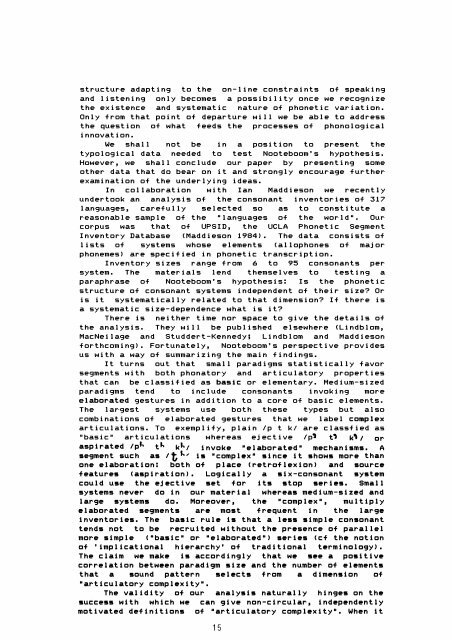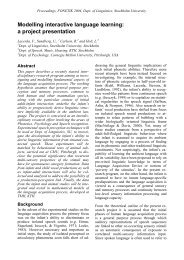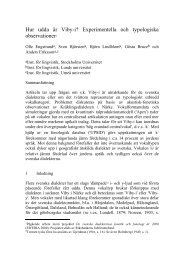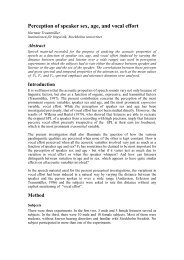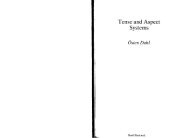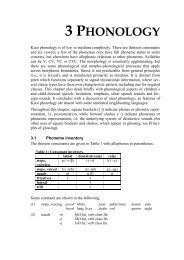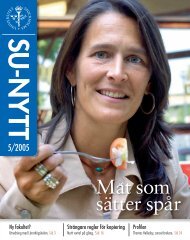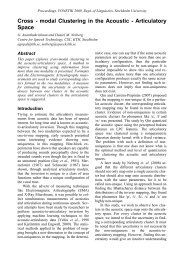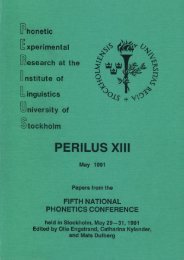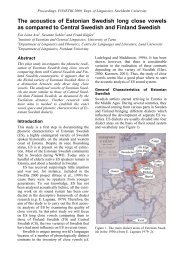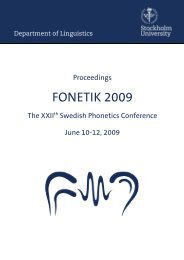perilus v - Stockholms universitet
perilus v - Stockholms universitet
perilus v - Stockholms universitet
You also want an ePaper? Increase the reach of your titles
YUMPU automatically turns print PDFs into web optimized ePapers that Google loves.
structure adapting to the on-line constraints of speaking<br />
and listening only becomes a possibility once we recognize<br />
the existence and systematic nature of phonetic variation.<br />
Only from that point of departure will we be able to address<br />
the question of what feeds the processes of phonological<br />
innovation.<br />
We shall not be in a position to present the<br />
typological data needed to test Nooteboom's hypothesis.<br />
However, we shall conclude our paper by presenting some<br />
other data that do bear on it and strongly encourage further<br />
examination of the underlying ideas.<br />
In collaboration with Ian Maddieson we recently<br />
undertook an analysis of the consonant inventories of 317<br />
languages, carefully selected so as to constitute a<br />
reasonable sample of the "languages of the world". Our<br />
corpus was that of UPSID, the UCLA Phonetic Segment<br />
Inventory Database (Maddieson 1984) . The data consists of<br />
lists of systems whose elements (allophones of major<br />
phonemes) are specified in phonetic transcription.<br />
Inventory sizes range from 6 to 95 consonants per<br />
system. The materials lend themselves to testing a<br />
paraphrase of Nooteboom's hypothesis: Is the phonetic<br />
structure of consonant systems independent of their size? Or<br />
is it systematically related to that dimension? If there is<br />
a systematic size-dependence what is it?<br />
There is neither time nor space to give the details of<br />
the analysis. They will be published elsewhere (Lindblom,<br />
MacNeilage and Studdert-Kennedy; Lindblom and Maddieson<br />
forthcoming) . Fortunately, Nooteboom's perspective provides<br />
us with a way of summarizing the main findings.<br />
It turns out that small paradigms statistically favor<br />
segments with both phonatory and articulatory properties<br />
that can be classified as basic or elementary. Medium-sized<br />
paradigms tend to include consonants invoking more<br />
elaborated gestures in addition to a core of basic elements.<br />
The largest systems use both these types but also<br />
combinations of elaborated gestures that we label complex<br />
articulations. To exemplify, plain Ip t kl are classfied as<br />
"basic" articulations whereas ejective Ip ' t ' k \ 1 or<br />
aspirated Ip t k / invoke -elaborated· mechanisms. A<br />
segment such as It ' is ·complex· since it shows more than<br />
one elaboration: both of place (retroflexion) and source<br />
features (aspiration). Logically a six-consonant system<br />
could use the eJective set for its stop series. Small<br />
systems never do in our material whereas medium-sized and<br />
large systems do. Moreover, the "complex", multiply<br />
elaborated segments are most frequent in the large<br />
inventories. The basic rule is that a less simple consonant<br />
tends not to be recruited without the presence of parallel<br />
more simple ("basic" or "elaborated") series (cf the notion<br />
of 'implicational hierarchy' of traditional terminology).<br />
The claim we make is accordingly that we see a positive<br />
correlation between paradigm size and the number of elements<br />
that a sound pattern selects from a dimension of<br />
"articulatory complexity".<br />
The validity of our analysis naturally hinges on the<br />
success with which we can give non-Circular, independently<br />
motivated definitions of ·articulatory complexity". When it<br />
15


